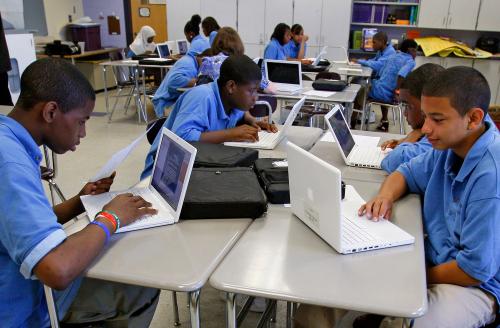Editor’s Note: President Bacow spoke at a joint AEI-Brookings event on February 7, 2019 called “The future of higher education.” A version of his remarks, lightly edited for length, is below. The event video is available here. One of the wonderful things about spending one’s life in Boston is that it’s one of the few cities in the nation where the dominant institutions are the universities and the nonprofits. Higher education is to Boston what finance is to New York, what automobiles are the Detroit, steel is to Pittsburgh, the entertainment industry is to LA. So people tend to pay a lot of attention to what’s going on in higher education in Boston. And indeed, you can’t pick up a newspaper without reading about something. What’s been interesting is that recently, every time you pick up a copy of The Boston Globe what we are reading about is some local college or area institution that is in the process of closing. Recently, Mount Ida College in Newton, Mass, closed. Green Mountain College in Vermont closed. Wheelock College merged with BU and then basically went out of existence. And if you look at the front page of The Boston Globe today or go online, you will see there’s an article about Hampshire College, which has just decided not to admit a class for next year and is teetering on the precipice, it appears, of bankruptcy. So what I want to ask is: Is this the beginning of the end of a bunch of institutions, as has been predicted by a number of our peers? In fact, my colleague at the Harvard Business School, Clay Christensen, has made a forecast saying that half the colleges and universities in America will no longer exist 15 to 20 years from now. That’s a pretty provocative statement. Kevin Carey, who many of us know, Kevin has written and said, “There will be a lot more institutions over the next 30 years which disappear than over the previous 30 years.” Terry Hartle has pointed out to me that people have been making predictions like this actually for a very long time about the impending collapse of American higher education. When I became president of Tufts, I decided I should learn something about Tufts, read some histories. So I read a very good book, which was written by Richard Freeland, later became president of Northeastern University, a really transformative president of Northeastern, and Richard is a historian of higher education. And he wrote a book that was entitled “Academia’s Golden Age”. It was about the Boston-area research universities basically since World War II and how they have evolved. I was surprised to read that in 1992 — I became president of Tufts in 2011 — he predicted that Tufts was going to be in steep decline and would face serious challenges going forward. No less an authority than Howard Bowen, who is, I think, known to many people in this room, predicted in his classic, “The Finance of Higher Education,” that our system of higher education was on an unstable trajectory. Why? Largely because of ever-rising tuition and student fees. When Howard wrote that, the average tuition at a private college in the United States was $3,000 per year.
The death of American higher education, as we know it, has been grossly over predicted, and consistently so … [these institutions] change and adapt quite a lot, only on a time constant that’s much longer than many other institutions in our society.
I could go on. The point I want to make, at least to start out, is that the death of American higher education, as we know it, has been grossly over predicted, and consistently so, and that the perception is that these great institutions don’t change. But in fact, if you read histories of them, what you find is that they do change and adapt, and they change and adapt quite a lot, only on a time constant that’s much longer than many other institutions in our society. That they are, in fact, quite durable and can adapt, in some cases quite quickly, especially when they face existential threats. I’m also not saying that the sector is not facing substantial pressures and challenges. We are. I’m just arguing that colleges and universities are far more adaptable and durable than some may give them credit for being.
Three major challenges facing higher education
So, what are the substantial challenges that I think we face? At this moment in time, we are confronting three major challenges. First, we are perceived as being elite institutions at a time in which the word “elite” has become a bad word (when applied to anything but a quarterback). Some people think that institutions like ours care far more about making themselves great than they do the world better. And I think therein lies a challenge for us, and we can talk about how do we in fact respond to that perception of elitism that we are often saddled with. Second, I think there’s public anger toward institutions like ours because people believe that we are too politically correct, that we lean left, that we do not truly embrace ideas from across the ideological spectrum, and that we are, in fact, more than that, intolerant of other views. Now I’m going to editorialize here. We have never had a speaker shouted down at Harvard or somebody who was unable to speak. We have speakers from across the spectrum. This past year, Mitch McConnell, Betsy Devos, Charles Murray all spoke at Harvard without incident. Yet having said that, there’s a perception that certain folks cannot speak at a place like Harvard. We work very hard to counter that, but it’s an issue for us. Third, I think a lot of the public anger over higher education is actually rooted in the ever-escalating cost and price of a college degree. People believe that we are incapable of controlling our own costs or, worse, that we will charge what the market will bear because we can. As the real cost of an education has increased, I think this has stoked cynicism and public anger over the higher education sector more broadly.
Public support is essential for higher education
What is important to understand is that all of public support for higher education is threatened by what I just described. And there is no institution of higher education in the country that is wealthy enough to exist without public support, and that includes Harvard University. All of us are dependent upon public support for research support, for indirect cost recovery, for guaranteed student loans that allow our graduate students to finance their education. We are dependent upon public support indirectly for the charitable deduction, for the tax-exempt status of our property. I could go on. So we ignore these criticisms at our peril. And ultimately, I think we need to engage and respond and address these in important ways. To that end, two points:
The value of research
Almost all of the discussion about what’s wrong with higher education tends to be filtered through the lens of undergraduate education. But in fact, the kinds of institutions that I’ve been at, as well as the great public universities of this country, are research universities. And research and education are joint products. And we should never lose sight of that. Ironically, while the public may be angry with higher education for the way in which we educate undergraduates, they love our institutions when it comes to the research that we do, when it comes to the economic opportunities that we generate, by the technologies that we create, by the companies that we spawn off. We live in a world in which the only truly scarce capital is human capital. Financial capital moves at the speed of light. One region no longer needs to be wealthy in terms of — or well-endowed with natural resources to be rich. It’s the ability to aggregate and concentrate and create human capital that determines the wealth of nations and regions. And what the great research universities do is exactly that. We are the sink at the end of the rest of the world’s brain drain. They send us their best and their brightest. And many of them never want to leave. And they stay and they enrich not only our institutions; they enrich this country. Thirty five percent of the Harvard faculty were born someplace else, not in this country. Forty percent of the Nobel Prizes awarded to US citizens in the sciences in recent years have gone to US citizens who were immigrants to this country. Pat Moynihan, who was a longtime faculty member at Harvard, a distinguished public servant, a United States Senator said: “If you want to build a great city, first build a great university and then wait a few hundred years.”
Colleges fueling the American Dream
Finally, it is really important that we get this right. When I say “we,” I don’t just mean for those of us who are privileged to lead these institutions. I mean we as a society. My parents were immigrants to this country. They were actually both refugees. My mother came on the second Liberty ship that brought refugees from Europe after World War II. She was an orphan. She had survived Auschwitz, the only member of her family who survived, actually the only Jew from her town who survived the war. I often say, “Where else in the world can you go literally in one generation from off the boat with nothing, absolutely nothing, to enjoy the kind of life and opportunity that I’ve enjoyed?” Historically, the nation’s colleges and universities have enabled the American dream. It is important that all of us work to continue to ensure that opportunity exists for future generations, just as it was created for so many of us.

![Welding instructor Darlene Thompson, 45, poses for a portrait at Los Angeles Trade-Technical College in Los Angeles, California, United States, June 27, 2016. Only 4.8 percent of U.S. welders were women in 2014, according to the U.S. Department of Labor. Thompson said: "I honestly donÕt care whether it [will] be a woman or a male [president]... What I want is someone who is morally and ethically correct... Right now we need a little peace." Picture taken June 27, 2016. REUTERS/Lucy Nicholson SEARCH "WOMEN WORKERS" FOR THIS STORY. SEARCH "THE WIDER IMAGE" FOR ALL STORIES TPX IMAGES OF THE DAY - S1AETRFYUOAC](https://www.brookings.edu/wp-content/uploads/2018/11/RTSJBN2-1.jpg?quality=75&w=500)





Commentary
The future of higher education: A conversation with Lawrence Bacow, President of Harvard University
March 1, 2019